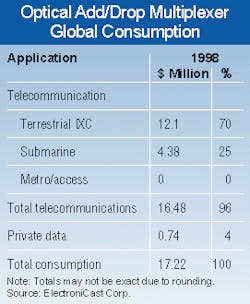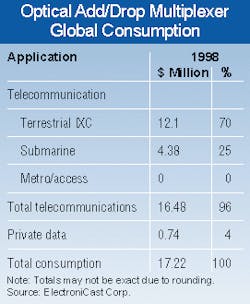Optical add/drop multiplexer market will benefit from continued success of DWDM
The successful introduction of optical-fiber amplifiers is boosting the market for dense wavelength-division multiplexing technologies. With a surge in deployment of DWDM links, the optical add/drop multiplexer (OADM) market will be a big beneficiary.
According to Optical Add/Drop Multiplexers and Components Forecast, a new study from ElectroniCast Corp. (San Mateo, CA), a research and analysis company, OADMs and their components are destined for continued market prosperity. ElectroniCast's research indicates the global consumption value of OADMs will accelerate from $17.2 million in 1998 to $687 million in 2003, and expand further to $6.66 billion by 2008.OADMs incorporate a wide variety of optoelectronic and passive optical components, so as the OADM market soars, the related component value responds similarly. The global consumption of OADM components in 1998 is estimated at $9.5 million. Consumption will rise rapidly through 2003 to about $534 million and reach $5.35 billion by 2008. For its study, ElectroniCast considered component pricing at estimated or forecast market prices, whether purchased or produced internally.
ElectroniCast defines OADMs as single-fiber units--one fiber in and one fiber out. The fiber can transport multiplexed signals ranging from 2 to 64 wavelengths deployed in the base year of 1998 and rising to 1024 wavelengths by the end of the forecast period, or 2008. Typical transport trunk cables contain many fibers, mainly in the range of 4 to 180 fibers or more. Some cables are also shared by multiple carriers, each using a few fibers.
Current network planning contemplates adding OADMs on a one-per-fiber basis, says ElectroniCast, typically using only one or two fibers for add/drops, with the remaining fibers carrying only through traffic. A duplicate set of OADMs will typically be installed in the protection fiber circuit, particularly in long-haul trunks. By the 2003-2008 period, however, more complex OADMs accommodating several fibers may emerge as a single system. The component consumption forecast will not be affected by this occurrence, with minimal affect to the OADM forecast, but the quantity and average price forecasts would be affected.
The report also states that major advancements will be achieved in WDM filter modules and in precise-wavelength transponders, optical-fiber amplifiers, remotely tunable dispersion compensators and light power attenuators, instrument nodes, and other components. Along with component technology changes, network concepts, subscriber demands, service offerings, and other major bandwidth demand will continue to evolve rapidly. In recognition of these future variables, Electroni Cast expects to publish an update of this report in 2001.
For more information on this report from ElectroniCast, call (650) 343-1348, fax (650) 343-1698, or e-mail: [email protected].

